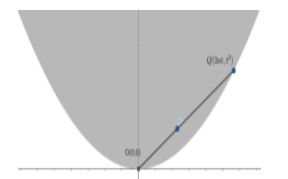Answer
394.2k+ views
Hint: We know that the vertex of the parabola \[{{x}^{2}}=4ay\]is \[O\left( 0,0 \right)\]. We know that the general point on the parabola \[{{x}^{2}}=4ay\] is \[Q\left( 2at,a{{t}^{2}} \right)\]. We know that if \[P\left( {{x}_{1}},{{y}_{1}} \right)\] and \[Q\left( {{x}_{2}},{{y}_{2}} \right)\] are two points, then \[R\left( {{x}_{3}},{{y}_{3}} \right)\] is divided by \[P\left( {{x}_{1}},{{y}_{1}} \right)\] and \[Q\left( {{x}_{2}},{{y}_{2}} \right)\] in the ratio \[m:n\]internally, then \[R\left( {{x}_{3}},{{y}_{3}} \right)\] is equal to \[R\left( \dfrac{m{{x}_{2}}+n{{x}_{1}}}{m+n},\dfrac{m{{y}_{2}}+n{{y}_{1}}}{m+n} \right)\]. By using this concept, we can find the equation of parabola.
Complete step-by-step answer:
We know that the vertex of the parabola \[{{x}^{2}}=4ay\]is \[O\left( 0,0 \right)\].From the question, we were given that O is the vertex of the parabola.
Now we should compare \[{{x}^{2}}=8y\] with \[{{x}^{2}}=4ay\].
\[\begin{align}
& \Rightarrow 4a=8 \\
& \Rightarrow a=2....(1) \\
\end{align}\]
So, from equation (1) we can write the vertex of the parabola \[{{x}^{2}}=8y\] is \[O\left( 0,0 \right)\].
We know that the general point on the parabola \[{{x}^{2}}=4ay\] is \[Q\left( 2at,a{{t}^{2}} \right)\].
So, from equation (1), we can write that the general point on the parabola \[{{x}^{2}}=8y\] is \[Q\left( 4t,2{{t}^{2}} \right)\].
We know that if \[P\left( {{x}_{1}},{{y}_{1}} \right)\] and \[Q\left( {{x}_{2}},{{y}_{2}} \right)\] are two points, then \[R\left( {{x}_{3}},{{y}_{3}} \right)\] is divided by \[P\left( {{x}_{1}},{{y}_{1}} \right)\] and \[Q\left( {{x}_{2}},{{y}_{2}} \right)\] in the ratio \[m:n\]internally, then \[R\left( {{x}_{3}},{{y}_{3}} \right)\] is equal to \[R\left( \dfrac{m{{x}_{2}}+n{{x}_{1}}}{m+n},\dfrac{m{{y}_{2}}+n{{y}_{1}}}{m+n} \right)\].

From the question, we were given that the point \[P(x,y)\] divides the line segment OQ internally in the ratio \[1:3\].
\[\begin{align}
& \Rightarrow P(x,y)=P\left( \dfrac{\left( 1 \right)(4t)+(3)(0)}{1+3},\dfrac{(1)(2{{t}^{2}})+(3)(0)}{1+3} \right) \\
& \Rightarrow P(x,y)=P\left( \dfrac{4t}{4},\dfrac{2{{t}^{2}}}{4} \right) \\
& \Rightarrow P(x,y)=P\left( t,\dfrac{{{t}^{2}}}{2} \right) \\
\end{align}\]
We know that the x-coordinate of \[P(x,y)\] is equal to x and the y-coordinate of \[P(x,y)\] is equal to y.
\[\begin{align}
& x=t....(2) \\
& y=\dfrac{{{t}^{2}}}{2}.....(3) \\
\end{align}\]
Now let us substitute equation (2) in equation (3), then
\[\begin{align}
& y=\dfrac{{{x}^{2}}}{2} \\
& \Rightarrow {{x}^{2}}=2y......(4) \\
\end{align}\]
So, the correct answer is “Option D”.
Note: Students may have a misconception that if \[P\left( {{x}_{1}},{{y}_{1}} \right)\] and \[Q\left( {{x}_{2}},{{y}_{2}} \right)\] are two points, then \[R\left( {{x}_{3}},{{y}_{3}} \right)\] is divided by \[P\left( {{x}_{1}},{{y}_{1}} \right)\] and \[Q\left( {{x}_{2}},{{y}_{2}} \right)\] in the ratio \[m:n\] internally, then \[R\left( {{x}_{3}},{{y}_{3}} \right)\] is equal to \[R\left( \dfrac{m{{x}_{2}}-n{{x}_{1}}}{m-n},\dfrac{m{{y}_{2}}-n{{y}_{1}}}{m-n} \right)\]. But we know that if \[P\left( {{x}_{1}},{{y}_{1}} \right)\] and \[Q\left( {{x}_{2}},{{y}_{2}} \right)\] are two points, then \[R\left( {{x}_{3}},{{y}_{3}} \right)\] is divided by \[P\left( {{x}_{1}},{{y}_{1}} \right)\] and \[Q\left( {{x}_{2}},{{y}_{2}} \right)\] in the ratio \[m:n\], then \[R\left( {{x}_{3}},{{y}_{3}} \right)\] is equal to \[R\left( \dfrac{m{{x}_{2}}+n{{x}_{1}}}{m+n},\dfrac{m{{y}_{2}}+n{{y}_{1}}}{m+n} \right)\]. So, this misconception should be avoided.
Complete step-by-step answer:
We know that the vertex of the parabola \[{{x}^{2}}=4ay\]is \[O\left( 0,0 \right)\].From the question, we were given that O is the vertex of the parabola.
Now we should compare \[{{x}^{2}}=8y\] with \[{{x}^{2}}=4ay\].
\[\begin{align}
& \Rightarrow 4a=8 \\
& \Rightarrow a=2....(1) \\
\end{align}\]
So, from equation (1) we can write the vertex of the parabola \[{{x}^{2}}=8y\] is \[O\left( 0,0 \right)\].
We know that the general point on the parabola \[{{x}^{2}}=4ay\] is \[Q\left( 2at,a{{t}^{2}} \right)\].
So, from equation (1), we can write that the general point on the parabola \[{{x}^{2}}=8y\] is \[Q\left( 4t,2{{t}^{2}} \right)\].
We know that if \[P\left( {{x}_{1}},{{y}_{1}} \right)\] and \[Q\left( {{x}_{2}},{{y}_{2}} \right)\] are two points, then \[R\left( {{x}_{3}},{{y}_{3}} \right)\] is divided by \[P\left( {{x}_{1}},{{y}_{1}} \right)\] and \[Q\left( {{x}_{2}},{{y}_{2}} \right)\] in the ratio \[m:n\]internally, then \[R\left( {{x}_{3}},{{y}_{3}} \right)\] is equal to \[R\left( \dfrac{m{{x}_{2}}+n{{x}_{1}}}{m+n},\dfrac{m{{y}_{2}}+n{{y}_{1}}}{m+n} \right)\].

From the question, we were given that the point \[P(x,y)\] divides the line segment OQ internally in the ratio \[1:3\].
\[\begin{align}
& \Rightarrow P(x,y)=P\left( \dfrac{\left( 1 \right)(4t)+(3)(0)}{1+3},\dfrac{(1)(2{{t}^{2}})+(3)(0)}{1+3} \right) \\
& \Rightarrow P(x,y)=P\left( \dfrac{4t}{4},\dfrac{2{{t}^{2}}}{4} \right) \\
& \Rightarrow P(x,y)=P\left( t,\dfrac{{{t}^{2}}}{2} \right) \\
\end{align}\]
We know that the x-coordinate of \[P(x,y)\] is equal to x and the y-coordinate of \[P(x,y)\] is equal to y.
\[\begin{align}
& x=t....(2) \\
& y=\dfrac{{{t}^{2}}}{2}.....(3) \\
\end{align}\]
Now let us substitute equation (2) in equation (3), then
\[\begin{align}
& y=\dfrac{{{x}^{2}}}{2} \\
& \Rightarrow {{x}^{2}}=2y......(4) \\
\end{align}\]
So, the correct answer is “Option D”.
Note: Students may have a misconception that if \[P\left( {{x}_{1}},{{y}_{1}} \right)\] and \[Q\left( {{x}_{2}},{{y}_{2}} \right)\] are two points, then \[R\left( {{x}_{3}},{{y}_{3}} \right)\] is divided by \[P\left( {{x}_{1}},{{y}_{1}} \right)\] and \[Q\left( {{x}_{2}},{{y}_{2}} \right)\] in the ratio \[m:n\] internally, then \[R\left( {{x}_{3}},{{y}_{3}} \right)\] is equal to \[R\left( \dfrac{m{{x}_{2}}-n{{x}_{1}}}{m-n},\dfrac{m{{y}_{2}}-n{{y}_{1}}}{m-n} \right)\]. But we know that if \[P\left( {{x}_{1}},{{y}_{1}} \right)\] and \[Q\left( {{x}_{2}},{{y}_{2}} \right)\] are two points, then \[R\left( {{x}_{3}},{{y}_{3}} \right)\] is divided by \[P\left( {{x}_{1}},{{y}_{1}} \right)\] and \[Q\left( {{x}_{2}},{{y}_{2}} \right)\] in the ratio \[m:n\], then \[R\left( {{x}_{3}},{{y}_{3}} \right)\] is equal to \[R\left( \dfrac{m{{x}_{2}}+n{{x}_{1}}}{m+n},\dfrac{m{{y}_{2}}+n{{y}_{1}}}{m+n} \right)\]. So, this misconception should be avoided.
Recently Updated Pages
Assertion The resistivity of a semiconductor increases class 13 physics CBSE

The Equation xxx + 2 is Satisfied when x is Equal to Class 10 Maths

How do you arrange NH4 + BF3 H2O C2H2 in increasing class 11 chemistry CBSE

Is H mCT and q mCT the same thing If so which is more class 11 chemistry CBSE

What are the possible quantum number for the last outermost class 11 chemistry CBSE

Is C2 paramagnetic or diamagnetic class 11 chemistry CBSE

Trending doubts
Difference between Prokaryotic cell and Eukaryotic class 11 biology CBSE

Difference Between Plant Cell and Animal Cell

Select the word that is correctly spelled a Twelveth class 10 english CBSE

Fill the blanks with the suitable prepositions 1 The class 9 english CBSE

What is the z value for a 90 95 and 99 percent confidence class 11 maths CBSE

Give 10 examples for herbs , shrubs , climbers , creepers

What organs are located on the left side of your body class 11 biology CBSE

What is BLO What is the full form of BLO class 8 social science CBSE

Change the following sentences into negative and interrogative class 10 english CBSE



